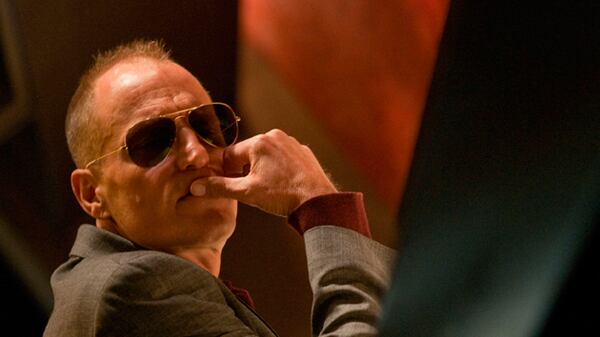In his three decades of acting, Woody Harrelson has gleefully taken on the roles of serial killers, psychopathic zombie hunters, and criminally stupid bartenders, but in his 50th year of life, he finally took a role that forced him to exhibit his greatest demons: a uniformed officer of the LAPD.

And not only a police officer, but a very, very bad one, teetering on the edge of sanity and lawlessness in Rampart, a new movie by director Oren Moverman. The film is a rematch for Harrelson and Moverman, who previously took the actor to other dark places in The Messenger. In that 2009 film, Harrelson—often thought of as a comic talent because of his Cheers beginnings—showed again he could be a Serious Actor, as a soldier who brings the news to families that their son or husband has been killed in combat. “He said he never wanted to play a soldier and he never wanted to play a cop,” said Moverman in an interview. “So I cast him as a soldier and now I’ve cast him as a cop.”
The Messenger earned Harrelson a Best Supporting Actor Oscar nomination and there is a chance his performance in Rampart could bring another nod (he has already been nominated for Best Actor, in 1996’s The People vs. Larry Flynt). Moverman said, “I knew he would be uncomfortable playing a cop, and I thought that would be great to get him out of his comfort zone. And when Woody’s out of his comfort zone, he works harder to convince himself that he’s true to the part.”
Moverman’s plans for him aside, Harrelson initially recoiled at such a step. An outspoken marijuana-rights activist with at least three arrests to his name, Harrelson’s easy Texas drawl becomes sharp and hard when he recalls his first reaction to the character upon reading the script, “I thought he was an asshole,” he said. “And I was like, Jesus. I don’t want to play this guy.”
Before walking away, however, he took a deep breath. “Then I was like—well, I gotta play it,” he recalled, shaking his head almost sadly. “It’s a great part. It’s Oren Moverman. I’ve just got to do it. It’s not even a question. Now let me find the humanity in this guy.”
Searching for that humanity, Harrelson ventured into his own personal heart of darkness, among the fearsome ranks of the Los Angeles Police Department. After researching America’s police lore (“I saw every cop movie, cop documentary, read cop books, went to the shooting range”), Harrelson came to L.A. and for a ridealong with a pair of the city’s finest. He said, “You know, I have a little trepidation being around cops as a lot of people do. But in this case, they weren’t going to be unfavorably disposed towards me, so it was a little bit easier. What was great was seeing how human they were. They were just great guys. They liked to talk about sports and girls and anything, just normal guys who just happen to be really powerful.”
Harrelson’s escorts not only exposed him to the real characters behind the uniforms, but also gave him a chance to speak to some on the other side of the fence. Harrelson said his guides stopped a group of young gangbangers so he might chat with them. “They’d pull them over. ‘OK, guys, hands on the head, turn and face the wall,’ they know the routine. So then they frisked them, asked them a few questions, and then they said, ‘OK, someone wants to talk to you.’
“I came over and they were like, ‘What the fuck is going on?’ And I’d ask them what it’s like being in a gang, or what are these guys normally like towards you. I had some incredible conversations with gangbangers. In situations like that, with hands on the head, it’s not the easiest conversation to have. But then I’d be in a liquor store parking lot, talking to one of the old-time gang members, one of the higher-ups. Incredible guy, incredible conversation. Then I walk away and the cops would say, ‘Oh that guy is a murderer. He’s a stone cold murderer.’ And I’d say, ‘But he seemed so cool!’ It was pretty amazing. That’s the greatest thing about this job—is you get to hang out with these people who you’d never be hanging out with. I’d never be hanging out with these cops or these gangbangers, and I came to like both of them.”
Having reconciled himself to the humanity of police officers in general, Harrelson had to find a way to accept his character in particular, finding a path to sympathy for a cop, Officer Dave Brown, who has done terrible things under the cover of his uniform and who becomes public monster No. 1 after being videotaped beating a fleeing suspect who slammed his car into him. “I think it would be very hard to play a character you have animosity towards,” Harrelson said.
Rampart is an intensely intimate portrait. (It had an Oscars qualifying run last year, and will officially be released on Feb. 10.) Moverman described what drew him to film this story. “I feel a certain attraction to movies about men who are in some sort of emotional turmoil and can no longer play the role they set out to play and get away with it,” he said. “There’s a lot of theater to being a man, and a certain kind of behavior that more and more in modern life you start feeling is something that’s not sustainable.” The film takes place in 1999, and hints at a conspiracy—active or unconscious—within the less militarized, post-riot LAPD to bring down old school cops like Brown, letting the viewers experience that changing world and what it is like to suddenly, from Brown’s perspective, find yourself declared a monster. “You end up on the other end of the movie not trying to figure out who done it,” Moverman said, “but to try and figure out your relationship with the character ... how you feel about someone who on the surface is irredeemable and there’s no salvation in his path. Do you feel compassion for him? Are you charmed by him? Those are the questions that say something about you as a viewer.”
Of finding his way into the part, Harrelson said: “The thing I really connected with the character on was family. I have daughters. I’m surrounded by women, even my dog is female. So this was an area I could relate to, and I really feel like Dave Brown, he does a lot of really morally questionable things but he has this side of him where he loves his family and it's heartbreaking to see how all that has fallen apart.”
In the original script, Brown’s family was a relatively minor plotline, but according to Harrelson and Moverman, after improvising the scenes between Brown and his two ex-wives (Cynthia Nixon and Anne Heche) and two daughters, that thread leapt to the foreground. Harrelson found himself going deep into some very dramatic personal scenes. Moverman’s directing technique is to discuss the script and the characters with the actors, to give them the basic parameters of where a scene needs to go, then let the actors improvise freely, shooting without rehearsal, so that the cameras can capture their visceral reactions to the moment. A scene depicting the final meeting in a hotel room between Harrelson and his daughters (played by young actresses Brie Larson and Sammy Boyarsky) was originally scripted at a single page, but Harrelson and the girls were so caught up in the moment that they kept going, creating a painful confrontation, with each side unable to express their feelings toward the other. Shooting the scene, Harrelson, in character, was so overwhelmed by his feelings that he chased his daughters into the hallway after they exited, a moment not in the script at all; it required the crew stationed out there to duck and hide as the cameras scrambled to capture the raw unfolding emotion. In the final cut, the one-page scene runs a full eight minutes.
While his roles of late veer back and forth from comic to darkly dramatic, at both poles, Harrelson has become perhaps the contemporary actor best able to capture characters on the edge–men fighting to keep from veering out of control, whose emotions are brewing barely below the surface. Sitting relaxed in a blazer and untucked shirt, he talked about what draws him to such combustible roles. “A buddy of mine, Tom Ballanco, has this statement, if you’re not standing on the edge, you’re taking up too much room. I love that. It’s not that I live by it, but I kind of love that idea. The emotional edge, the comedic edge. The edge of things. To just sit fat and comfortable in the middle is not interesting to me. I find those characters much more interesting who have that edge to them. In life though, I’m pretty relaxed. I can get into some weird moods, of course. But generally, I can’t imagine a better life than the one I have. I’m very friggin’ happy. Psyched about it. I don’t really want for anything. I don’t need more money. I don’t need a better part. There’s not much reason for me to be anxious or unhappy or angry.”
Asked whether this comfort leads him to seek out roles that will take him to darker places, Harrelson nodded. “Maybe. I mean in a way, it's not like I created these roles, these roles were already written. It’s not that I was searching them out. In fact, if it were up to me I’d just be doing light comedy.”
Editor's Note: An earlier version of this story misstated the official release date of Rampart. It is Feb. 10.






